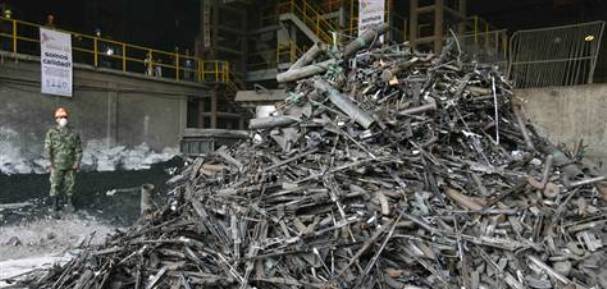The Demobilization, Disarmament and Reintegration (DDR) process in Colombia was built nationally, but it was consolidated at the sub-national level: the Mayoral Offices of Bogota and Medellin developed programmes for the reintegration of ex-combatants that played a crucial role in both sustaining and contesting the national policy of reintegration The analysis of these policies contributes to the understanding of the role that municipal authorities play in underpinning and redefining the DDR national policies.
—-
 This article is the ninth contribution in our new Academic Spotlight blog series that features recent research findings on security sector reform and security governance published in international relations academic journals.
This article is the ninth contribution in our new Academic Spotlight blog series that features recent research findings on security sector reform and security governance published in international relations academic journals.
This contribution summarizes research originally published here:
Francy Carranza-Franco (2014) A sub-national approach to state-building and security: the role of municipal institutions in Colombia’s DDR process, Conflict, Security & Development, 14:3, 245-274.
As part of the partnership between the Conflict, Security & Development Journal and the Centre for Security Governance, this journal article will be available for six months free and open access exclusively through this link:
http://www.tandfonline.com/doi/full/10.1080/14678802.2014.923149#abstract
—-
There is a strong tendency in the international development literature to assume that ‘local’ means national. Expressions such as ‘local capacity’, ‘national ownership’ and ‘community empowerment’ have been adopted by policy-makers and practitioners to stress the convenience of taking into account the states or the communities as partners in policies of peacebuilding and statebuilding implemented by multilateral organizations. However, some approaches may focus more in ownership from the recipient communities rather than in statebuilding or vice versa, which may result in conflicting goals and activities. Thus, there is a lack of clarity about what ‘local’ actually means in practice as it is a complex system of political, economic and social structures subject to continuous accommodations.
This article addresses the role of local actors in statebuilding, exploring the relationship between the authorities at the national and the municipal level in the DDR process that took place in Colombia during the two terms of Alvaro Uribe’s Presidency (2002–2006 and 2006–2010). This process was built nationally, but it was at the sub-national level that it was consolidated: the Mayoral Offices of the cities of Bogotá and Medellín sustained the provision of services to assist ex-combatants and contributed to the renewal of the strategy of reintegration. Remarkably, as the conflict has different dynamics in Bogotá and Medellín, their approaches to reintegration were linked to the human security needs of their dwellers, which in turn contrasted with the military security needs faced by the national government.
Local ownership and Colombia’s DDR process
The UN and the World Bank understand that national ownership is essential for the success and sustainability of DDR programmes. Both recognize that building a national strategy on DDR implies the participation of political and non-political local actors including the central government, authorities at the regional and municipal levels, as well as NGOs, grassroots organizations and civil society groups. Subsequently, there has been an emphasis in capacity and state-building activities such as training and funding for the involvement of local authorities and civil society groups and the supplying of technical assistance addressed to national and sub-national authorities. However, the Colombian DDR is very a-typical compared to cases in Africa and Asia in which these multilateral organizations have experience. First, it was a nation-led process, although there was some involvement from multilateral organizations and foreign countries, their activities were limited to monitoring the demobilization, providing financing and technical assistance to specific tasks in the reintegration phase. Secondly, the Colombian DDR took place in the midst of an ongoing conflict, but it was also part of a strategy of security with differential treatment to each armed group: the government negotiated the collective demobilization of paramilitary groups while fostering the desertion of guerrilla members as a strategy to weaken the guerrillas, bestowing upon them also the status of demobilized ex-combatant. Finally, the DDR was operating within the fundamental paradox of the Colombian state: a system of long-term institutions coexisting and interacting with a medium-intensity war.
It was the Colombian Government that headed the design, administration, fundraising and implementation of the programme. However, from the sub-national point of view, the demobilization and disarmament of combatants took place with no participation or even consultation with the municipal and other regional authorities, even in decisions directly affecting communities, such as the creation of cantonment areas in their territories. For the reintegration part, the strategy of President Uribe’s Government was to make use of the same programmes, methods and infrastructure that had been functioning since the 1990s for previous demobilization of guerrilla groups. However, these programmes were unable to cope with the reintegration task, simply because their budget and resources did not increase at the same rate than the demand in number and characteristics of these new demobilized ex-combatants.
Demobilization, Disarmament and Reintegration in Colombia: A tale of two cities
Meanwhile, the Mayoral offices of Medellín and Bogotá developed programmes to provide services to the demobilized population migrating to or living in their cities. Medellín absorbed a significant portion of the collectively demobilized ex-paramilitaries and its municipal institutions took over responsibilities for the central administration. In practice, then, they had to deal with the pitfalls of the DDR policy and the loopholes in the agreement between the paramilitary leaders and the national government. Additionally, the city suffered the problems and challenges of the reintegration of ex-combatants: first, the immediate consequences of a sudden increase in dwellers, creating pressure to provide housing and jobs as well as health and education services; and second, addressing the grievances of the non-combatant population as well as the victims of these paramilitary groups, avoiding perceptions of preferences towards the perpetrators and possible discrimination against the ex-combatants. To tackle these issues, the municipal programme of ‘Peace and Reconciliation’ was created. Its main objective was to contribute to the reconciliation process in the city by merging two areas of action previously separated: the reintegration of ex-combatants and the social care for victims of violence. Additionally, it included activities in the prevention of violence, care services to victims of violence and vulnerable communities and rehabilitation of perpetrators of violence. More importantly, this programme came to lay the foundations for the national reintegration programme that is currently implemented nationwide. It is also noteworthy that the Mayor of Medellín provided resources to the Organization of American States’ Mission to monitor the Colombian DDR process. As one of the main problems of the Mission when created was to look for financial resources for basic functioning, the Municipality of Medellin agreed on including them in its own budget.
In Bogotá, the Demobilization, Disarmament and Reintegration (DDR) process was initially perceived as a reality far from the everyday lives of the city inhabitants, hence beyond the scope of action and responsibility of the municipal authorities. However, some isolated cases of violence and street protests raised awareness of the demobilized population living in otherwise quiet neighborhoods, bringing unwanted media attention and creating uneasy feelings towards these newcomers. Bogotá had to deal with the housing and security needs of the ex-combatants that had deserted from the guerrillas and that the central government had allocated in shelters in the capital city. This shelter scheme entered a period of crisis due to the overcrowding and unhealthy living conditions, making the failures in the strategy of reintegration clearly apparent to the public. Then, Bogotá’s authorities took the role of questioning the reintegration process rather than enduring it as Medellín had. However, it could be said that the security issues in Bogotá were not a threat to the state’s monopoly of force or to the sovereignty of the national or municipal administrations. Nevertheless, Bogota’s Mayoralty then fostered debates nationwide and created an arena to redefine the institutions and policies from the central government, a process that resulted in the replacement of the old reintegration programme with the national office of the High Councillor for Reintegration (ACR in Spanish). In turn, the ACR adopted the strategy created by Peace and Reconciliation in Medellín for two years and then, updated it in a new reintegration approach according to its needs as a national institution.
Fostering local ownership and legitimacy: the role of sub-national and municipal authorities
It can be concluded that, as municipal institutions are closer to their citizens than the central government, fostering co-ordination, communication and decentralization between national and sub-national authorities has a significant role to play when building sustainable state capacity from the bottom up. This, I argue, encourages ownership and legitimacy, particularly in terms of the capacity to respond to security needs at the sub-national level in tandem with national security needs. In sum, international organizations and donor countries should pay more attention to the dynamics that take place at the municipal and sub-national levels, and in the role of intermediate authorities and sub-national administration structures in providing stability and security in post-conflict situations.
Francy Carranza Franco is a PhD Candidate at the School of Oriental and African Studies (SOAS), London. Having investigated extensively the Colombian armed conflict, her current research interests is on citizenship and its relationship to security in situations of war and conflict. Currently she is a senior researcher at the Observatory of Land Restitution and Property Rights Regulation.
Tags: Academic Spotlight, Colombia, DDR, peacebuilding, SSR, statebuilding






 Visit the Centre for
Visit the Centre for